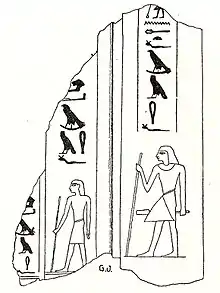| Merenre Nemtyemsaf II | ||||||||||||||||||||||||||||||||||||||||||||||||||
|---|---|---|---|---|---|---|---|---|---|---|---|---|---|---|---|---|---|---|---|---|---|---|---|---|---|---|---|---|---|---|---|---|---|---|---|---|---|---|---|---|---|---|---|---|---|---|---|---|---|---|
| Menthesouphis (Africanus after Manetho), Antyemsaf | ||||||||||||||||||||||||||||||||||||||||||||||||||
 A false door fragment depicting Nemtyemsaf II from the Pyramid of his mother Neith. | ||||||||||||||||||||||||||||||||||||||||||||||||||
| Pharaoh | ||||||||||||||||||||||||||||||||||||||||||||||||||
| Reign | 1 year and 1 month, 2194 BC,[1] 2184 BC,[2][3][4] 2180 BC,[5] 2152 BC,[6] | |||||||||||||||||||||||||||||||||||||||||||||||||
| Predecessor | Pepi II Neferkare | |||||||||||||||||||||||||||||||||||||||||||||||||
| Successor | Neitiqerty Siptah Nitocris (disputed) | |||||||||||||||||||||||||||||||||||||||||||||||||
| ||||||||||||||||||||||||||||||||||||||||||||||||||
| Father | Pepi II Neferkare | |||||||||||||||||||||||||||||||||||||||||||||||||
| Mother | Neith A[7] | |||||||||||||||||||||||||||||||||||||||||||||||||
| Dynasty | 6th Dynasty | |||||||||||||||||||||||||||||||||||||||||||||||||
Merenre Nemtyemsaf II was an ancient Egyptian pharaoh, the sixth and penultimate ruler of the 6th Dynasty.[8] He reigned for 1 year and 1 month in the first half of the 22nd century BC, at the very end of the Old Kingdom period. Nemtyemsaf II likely ascended the throne as an old man, succeeding his long-lived father Pepi II Neferkare at a time when the power of the pharaoh was crumbling.
Attestations
Merenre Nemtyemsaf II is attested on the 4th line, column 6 of the Turin canon, a king list redacted in the early Ramesside Period. Although his name is lost in the canon, the duration of its reign is still readable as 1 year and 1 month, following the reign of Pepi II Neferkare.[9] Nemtyemsaf II is also attested on the 39th entry of the Abydos King List,[9] which dates to the reign of Seti I and constitutes one of the best preserved historical records for the end of the Old Kingdom and beginning of the First Intermediate Period. The Abydos king list is the only document where Nemtyemsaf II bears the throne name Merenre. A later historical source also records the existence of Nemtyemsaf II: indeed he is mentioned in Manetho's Aegyptiaca, a history of Egypt written in the 3rd century BC. Manetho gives Nemtyemsaf II's name as Menthesouphis and credits him with one year of reign.[1]

There is only one contemporary artefact known for sure to belong to Nemtyemsaf II. It is a damaged false door inscribed with Sa-nesu semsu Nemtyemsaf meaning "The elder king's son Nemtyemsaf" and discovered near the site of the pyramid of Neith, Pepi II's half-sister and queen and most likely Nemtyemsaf II's mother.[7][9] As indicated by the epithet of "elder king's son", this inscription was made before Nemtyemsaf's accession to the throne, when he was the heir apparent and also shows that he bore this name before becoming a pharaoh.[10] A second artefact may possibly belong to Nemtyemsaf II: a decree to protect the funerary cults of queens Ankhesenpepi I and Neith discovered in the mortuary temple of queen Neith.[11][12] If this decree was indeed issued by Nemtyemsaf II, his Horus name would be S[...]tawy meaning "He who causes the two lands to...".
Reign
Nemtyemsaf II succeeded his father Pepi II after his extremely long reign, believed to have been between 64 and 94 years long. Nothing is known for certain of Nemtyemsaf's activities but he likely had to face the collapse of the royal power and the rise of the provincial nomarchs. Less than 3 years after his death, the Old Kingdom period ended and the chaos of the First Intermediate Period started. Nemtyemsaf II may possibly have started a pyramid for himself and, if so, it would likely have been in Saqqara,[9] close to that of his father.[13]
Herodotus story
In his Histories, the Greek historian Herodotus records a legend according to which an Egyptian queen Nitocris took revenge on the murder of her brother and husband by a rioting mob, allegedly Nemtyemsaf II, by drowning all his murderers during a banquet where she had gathered them. It is now recognized that the name "Nitocris" is a result of conflation and distortion from the name of a real male pharaoh, Neitiqerty Siptah, who succeeded Nemtyemsaf II.[14]
Notes
- 1 2 Jürgen von Beckerath: Chronologie des pharaonischen Ägypten (Chronology of the Egyptian Pharaohs), Mainz am Rhein: Verlag Philipp von Zabern (1997), p. 152.
- ↑ Michael Rice: Who is who in Ancient Egypt, Routledge London & New York 1999, ISBN 0-203-44328-4, see p. 111
- ↑ Jaromir Malek: The Old Kingdom in Ian Shaw (editor): The Oxford History of Ancient Egypt, Oxford University Press, new edition (2003), ISBN 978-0192804587
- ↑ Peter A. Clayton: Chronicle of the Pharaohs: The Reign-by-Reign Record of the Rulers and Dynasties of Ancient Egypt, Thames & Hudson (2006), ISBN 0-500-28628-0, see p. 64.
- ↑ Thomas Schneider: Lexikon der Pharaonen, Düsseldorf 2002.
- ↑ Erik Hornung (editor), Rolf Krauss (editor), David A. Warburton (editor): Ancient Egyptian Chronology, Handbook of Oriental Studies, Brill 2012, ISBN 978-90-04-11385-5, available online copyright-free, see p. 491.
- 1 2 Aidan Dodson and Dyan Hilton: The Complete Royal Families of Ancient Egypt, Thames & Hudson (2004), ISBN 0-500-05128-3, see p. 73
- ↑ Jürgen von Beckerath: Handbuch der ägyptischen Königsnamen, Münchner ägyptologische Studien, Heft 49, Mainz : Philip von Zabern, 1999, ISBN 3-8053-2591-6, see pp.64–65, king No 6.
- 1 2 3 4 Darrell D. Baker: The Encyclopedia of the Pharaohs: Volume I - Predynastic to the Twentieth Dynasty 3300–1069 BC, Stacey International, ISBN 978-1-905299-37-9, 2008, p. 211–212
- ↑ Gustave Jéquier: Les pyramides des reines Neit et Apouit, Imprimerie de l'Institut Français d'Archéologie Orientale, Cairo (1933), new edition: Service des antiquites de l'Egypte (1984), ISBN 978-9770104934.
- ↑ Kurt Sethe (editor): Urkunden des ägyptischen Altertums, Vol. 1: Urkunden des alten Reiches, Hinrichs, Leipzig 1933, num. 307 available online.
- ↑ Hans Goedicke: Königliche Dokumente aus dem Alten Reich, Wiesbaden: Otto Harrassowitz (1967), p. 158–162.
- ↑ Miroslav Verner: Die Pyramiden, Reinbek 1997, p. 415.
- ↑ Kim Ryholt: "The Late Old Kingdom in the Turin King-list and the Identity of Nitocris, Zeitschrift für ägyptische, 127, 2000. See p. 91